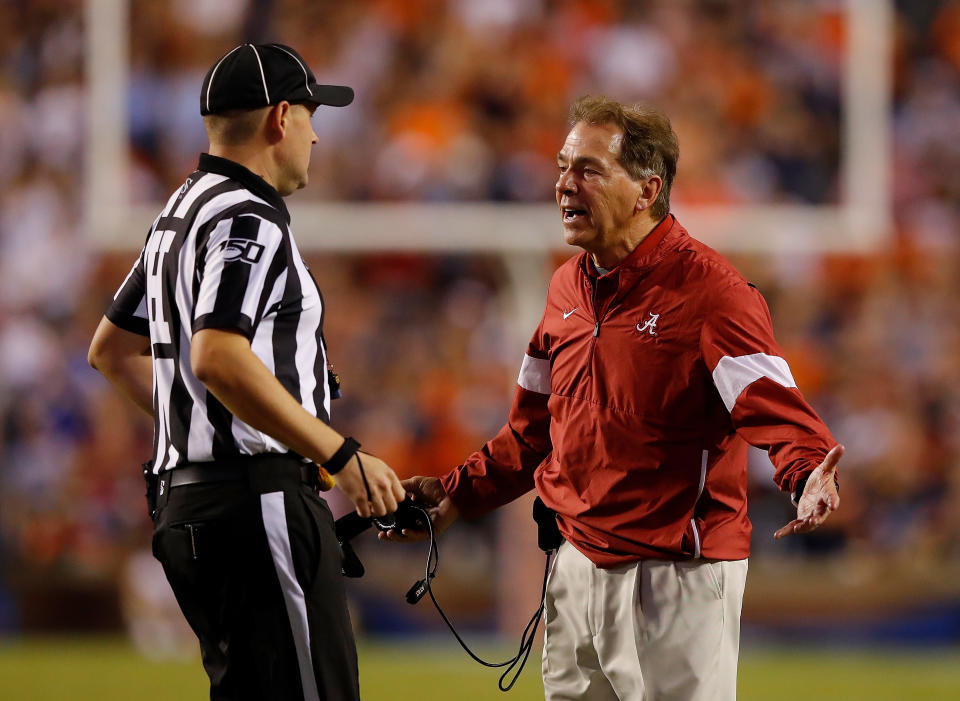NCAA approves college football rule changes, including one that addresses 2019 Iron Bowl controversy
College football will have some new rules in place when the 2020 season kicks off — whenever that may be.
The NCAA announced Tuesday that the NCAA Playing Rules Oversight Panel approved a change involved with the targeting rule, instituted a time guideline for replay reviews and adjusted protocol for pregame interactions between opposing teams and the jersey numbers players are allowed to wear.
Also of note: A controversy from last year’s Iron Bowl seems to have influenced a minor change to clock administration.
The new rules were first proposed by the NCAA Football Rules Committee in February and formally approved on Monday.
Alabama-Auburn controversy results in rule change
On the heels of a controversial field goal in last year’s Iron Bowl, a clock administration rule regarding instant replay was also approved.
Moving forward, if the game clock expires at the end of a half but replay determines that there should be time remaining and it is a situation where the clock would resume on the referee’s signal, there needs to be at least three seconds remaining in the half to restore time to the clock. Otherwise, the half is declared over.
You could call this change the “Saban rule.” Or maybe the “Malzahn rule,” depending on your point of view.

Alabama coach Nick Saban was furious last November when Auburn was allowed to kick a field goal at the end of the first half of the Iron Bowl — a game Auburn went on to win 48-45. Auburn gained 15 yards on a pass play with eight seconds and no timeouts remaining. Auburn’s Boobee Whitlow went down inbounds, but the officials ruled that the clock expired. It had not. After a review, it showed that there was one second remaining when Whitlow went down.
Because of the review, Auburn was able to run its field goal unit onto the field and snap the ball as soon as the official signaled the ball ready for play. Anders Carlson promptly drilled a 52-yarder, cutting Alabama’s lead to 31-27 at halftime.
Without the review, Auburn would not have had the time to do so. Additionally, NCAA rules state that there must be two seconds on the clock for an offense to spike the ball.
"Nick Saban on the sideline, not a happy guy." pic.twitter.com/fV2fRPObJg
— CBS Sports (@CBSSports) November 30, 2019
Speeding up instant replay
The NCAA Rules Committee believed that replay reviews were taking too long, and the Oversight Panel agreed. The panel has instituted a new guideline for replay officials to complete reviews in “less than two minutes” in an effort to improve pace of play.
The exceptions to that two-minute time frame are reviews that are viewed as “exceptionally complicated” or involve “end-of-game issues.” Those should be completed “as efficiently as possible without a stated time limit,” the NCAA said in a press release.
Steve Shaw, the national coordinator of officials, said the goal was to be more efficient.
“If you get to two minutes, it’s time to wrap it up,” Shaw said on a February conference call with reporters. “If you’re at two minutes and you don’t know the answer, it’s time to let it stand and not continue to drag the process out.”
Players ejected for targeting can stay on sideline
When the Rules Committee met back in February, the targeting rule was a major topic of conversation. In the end, though, only one change came to fruition.
Players who get ejected for a targeting foul will now be allowed to remain on the sideline instead of having to go back to the locker room for the remainder of the game. Players had been escorted to the locker room following the disqualifications since the targeting rule was instituted in 2013.
“The player now will not have to leave the playing enclosure. The player can stay in the team area and be with the team. Other ejection fouls — such as fighting or two unsportsmanlike conduct penalties — they will still have to leave the playing enclosure,” Shaw said.
The changes that were made to the targeting rule before the 2019 season will remain in place.
“I think the targeting rule is working where we want it, and the trend is very, very good,” Shaw said. “Preliminary information around injuries is very good. Not only are we seeing results in the data, but it’s changing player behavior.”
Players can wear No. 0
The panel approved a rule that makes it so only two players on a roster can wear duplicate numbers. Those players must play different positions and cannot be on the field at the same time.
Because rosters are so large, it has been common for more than two players to wear the same number. A recent example was at Michigan where defensive lineman Rashan Gary, quarterback Wilton Speight and kicker Quinn Nordin all wore No. 3. Now it’s down to only two.
To help combat that change, No. 0 has been added as a legal wearable number.
Limiting pregame confrontations
Other changes are designed to combat pregame confrontations in the sport.
Officials’ jurisdiction over the game now begins 90 minutes before kickoff instead of 60 minutes. Additionally, a coach must be on the field during pregame warmups involving players and all players must be identified by numbers.
There were several pregame scuffles last season. Most notably, cameras captured a punch thrown by Kentucky star Lynn Bowden prior to the Belk Bowl against Virginia Tech.
More from Yahoo Sports:

